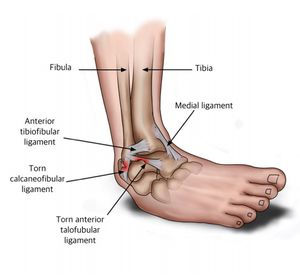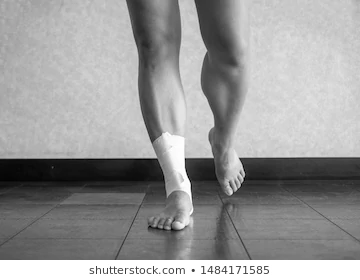Lateral Ankle Injuries
- Edel Kieran

- Feb 2, 2020
- 5 min read
An ankle sprain is a very common injury. In general, sports people sustain ankle sprains more commonly than the general population. Research has shown lateral ligament (ligaments on the outside of your ankle) sprains are the most frequently reported type of injury in sport. In addition, studies show that if you have sprained your ankle once, you are up to 8 times more likely to sprain your ankle again!

Ankle Anatomy:
The ankle joint is a joint is a synovial joint located in the lower limb. It is formed by the bones of the lower leg (tibia and fibula) and the foot (talus). It is a hinge joint, it allows dorsiflexion and plantarflexion of the foot (up and down movement).

There are two main sets of ligaments that help to stabilise this joint ,on the inside (medial) and the outside (lateral) of the ankle.

There is only one ligament on the medial side of the ankle, called the deltoid ligament. However, there are 3 ligaments in the lateral ligament complex.
1. The Anterior Talo – Fibular Ligament (ATFL)
2. The Calcaneo – Fibular Ligament (CFL)
3. The Posterior Talo – Fibular Ligament (PTFL).

Type of ankle sprains:
The ligament on the inside of the ankle (deltoid) is much stronger than the lateral ligaments and is injured less commonly because of that.
Inversion type, lateral ligament injuries represent the majority of ankle sprains (85%). To break that down, the ligaments on the outside of the ankle are injured most commonly and they are hurt in incidents where the ankle rolls outward while your foot turns inward. This causes the lateral ligaments to stretch or tear.

The most common mechanism of injury is plantarflexion and inversion. This normally happens when you shift your weight quickly over your weight bearing foot. For example, if you’re coming down a hill and your foot turns in or if you try to turn or pivot quickly and your ankle gives way.
Studies have shown that the more your foot is pointed downward (plantarflexed), the worse the severity of the sprain. In general, a person is much more likely to injure their dominant foot than their non – dominant foot.
We have briefly mentioned the basic anatomy of the ankle. The ligament most commonly injured in lateral ankle sprains is the anterior talofibular ligament (ATFL).
Can you predict whether you will sprain your ankle?
There are intrinsic factors (inside the person) and extrinsic factors (outside the person) at play.
In general, research on intrinsic risk factors for initial ankle sprains is quite unreliable. Some studies have shown that increased BMI, strength around the ankle joint and reduced proprioception (balance type activities) are associated with significantly increased risk of lateral ankle sprains.
In addition, it has been shown that females are at a higher risk when compared to males and children are more likely to sprain their ankle compared to teenagers and adults.
Research has also shown that indoor and court sports are the highest risk activities for ankle sprains.

However, the most common risk factor overwhelmingly is previous history of sprain!
Individuals who suffer numerous repetitive ankle sprains have been reported as having ankle instability and increased likelihood of re-injury.
Poor rehabilitation after an initial ankle sprain increases the risk of another sprain. If stability around the outside of the ankle is compromised, it can put an athlete at risk of further injuries, not only at the knee but further up the kinetic chain.
Grading Ankle Sprains:
Grade I : microscopic injury without stretching of the ligament on a macroscopic / obvious level.
Grade II : macroscopic stretching, but the ligament remains intact
Grade III : complete rupture of the ligament
However, accurate grading of a ligament injury without high level imaging can be difficult as there is more than one ligament involved in the lateral ligament complex. Another proposed grading system is;
Grade I : Mild - Little swelling and tenderness with little impact on function
Grade II : Moderate - Moderate swelling, pain and impact on function. Reduced proprioception, ROM and instability present.
Grade III : Severe - Complete rupture, large swelling, high tenderness loss of function and marked instability.

Chronic Ankle Issues:
Although an ankle sprain may seem like a relatively mild injury, insufficient rehabilitation can lead to ongoing symptoms after the incident. Some research has shown that 55 – 72 % of patients have issues ongoing up to 18 months after initial injury.
Chronic ankle instability has been described as:
Persistent pain.
Swelling.
Feeling of “giving way”.
Recurrent injury sprains that continue for at least 12 months after initial injury.

People presenting with chronic ankle instability tend to show decreased proprioception, muscular imbalances and impaired neuromuscular control. This could be a result of inappropriate rehabilitation after the initial injury.
Recently, it has been shown that chronic ankle instability is a leading cause of ankle joint osteoarthritis down the line and it also contributes to an increased risk of falls.

Lateral Ligament Sprain Rehabilitation / Injury Prevention:
Even though an ankle sprain may feel like quite a minor injury, it is important to implement a full and progressive rehabilitation programme from the initial injury.
As we have seen, the deficits caused by not rehabbing an ankle sprain properly can set you up for constant niggles throughout your life. These programmes have been shown to reduce the rate of recurrent ankle sprains up to 12 months after acute ankle sprain!
Early implementation is key to the success of the rehab regime. First week exercises have been seen to result in higher overall activity levels without any increase in symptoms (pain, swelling etc) than traditional RICE (rest, ice, compression, elevation) therapy alone.
Rehab programmes should be implemented as soon as the person can tolerate some movement.

Treatment modalities such as RICE, EMS etc. have not been shown to reduce recovery time but have been reported as effective in terms of pain relief. This in turn may allow an earlier introduction of a rehab programme which in turn may actually speed up recovery time.
The goals of the rehab programme will be:
Reduce pain and swelling.
Restore range of motion
Restore strength & proprioception
Sports specific movements & return to play.
The rate of progression will vary depending on the severity of the injury. The programme will incorporate static and dynamic exercises and will progress using different surfaces and by changing environmental factors.

Interestingly, although these programmes are very effective in preventing recurrent sprains, the evidence for effectiveness in reduction in first time ankle sprains is less convincing!
Some studies recommend that athletes should wear taping or a brace for up to one year after the initial injury. Again, this will depend on the severity of your initial ankle sprain.
Although everybody who has suffered an ankle sprain is recommended to complete a full rehabilitation programme, it is not always enough to compensate for the lack of stabilisation provided by the lateral ligament complex and surgery is occasionally required.
If you have any questions or would like to implement an ankle rehabilitation programme, don't hesitate to get in touch!
Edel 😊

REFERENCES
Roos, K.G., Kerr, Z.Y., Mauntel, T.C., Djoko, A., Dompier, T.P. and Wikstrom, E.A., 2017. The epidemiology of lateral ligament complex ankle sprains in National Collegiate Athletic Association sports. The American journal of sports medicine, 45(1), pp.201-209.
Doherty, C., Delahunt, E., Caulfield, B., Hertel, J., Ryan, J. and Bleakley, C., 2014. The incidence and prevalence of ankle sprain injury: a systematic review and meta-analysis of prospective epidemiological studies. Sports medicine, 44(1), pp.123-140.
McKeon, P.O. and Donovan, L., 2019. A Perceptual Framework for Conservative Treatment and Rehabilitation of Ankle Sprains: An Evidence-Based Paradigm Shift. Journal of athletic training, 54(6), pp.628-638.
Chen, E.T., McInnis, K.C. and Borg-Stein, J., 2019. Ankle sprains: evaluation, rehabilitation, and prevention. Current Sports Medicine Reports, 18(6), pp.217-223.
Abassi, M., Bleakley, C. and Whiteley, R., 2019. Athletes at late stage rehabilitation have persisting deficits in plantar-and dorsiflexion, and inversion (but not eversion) after ankle sprain. Physical Therapy in Sport, 38, pp.30-35.




Comments